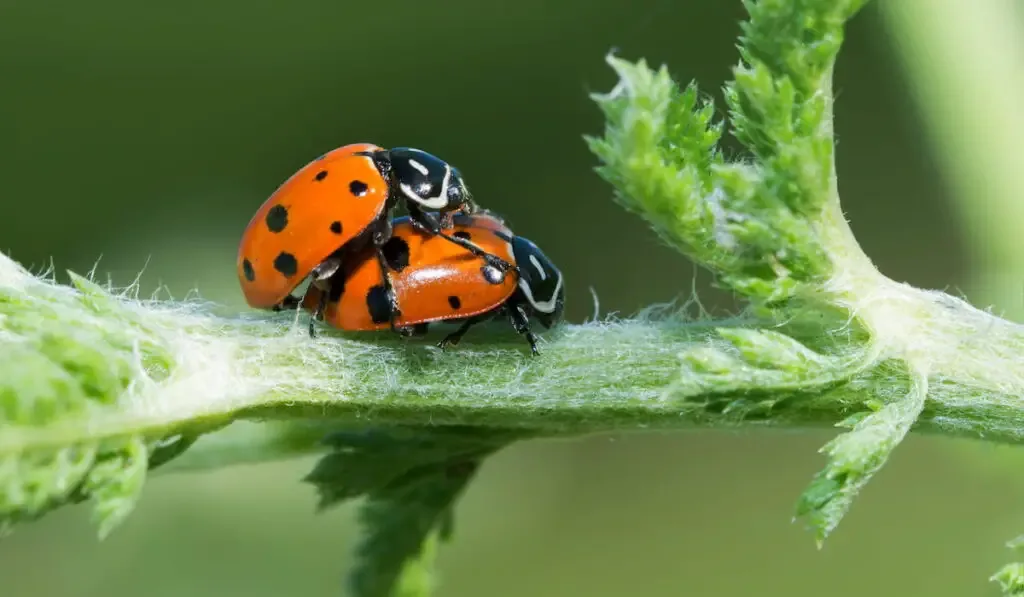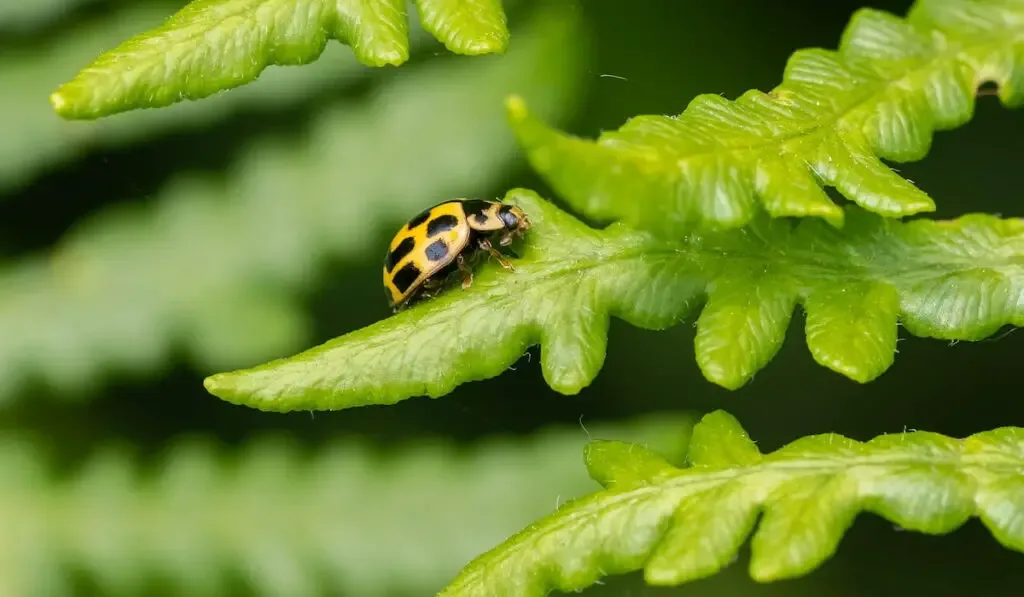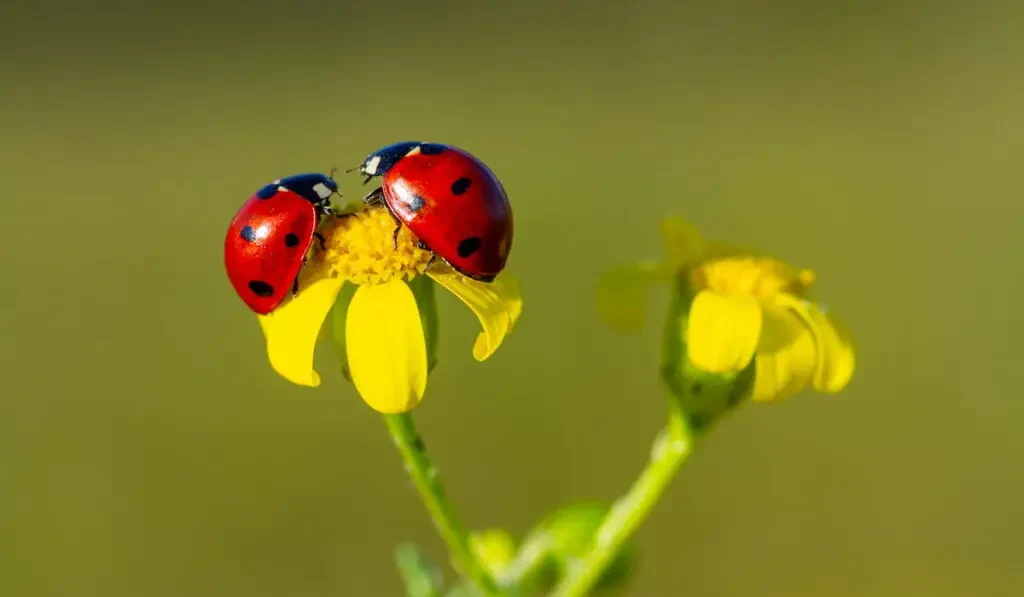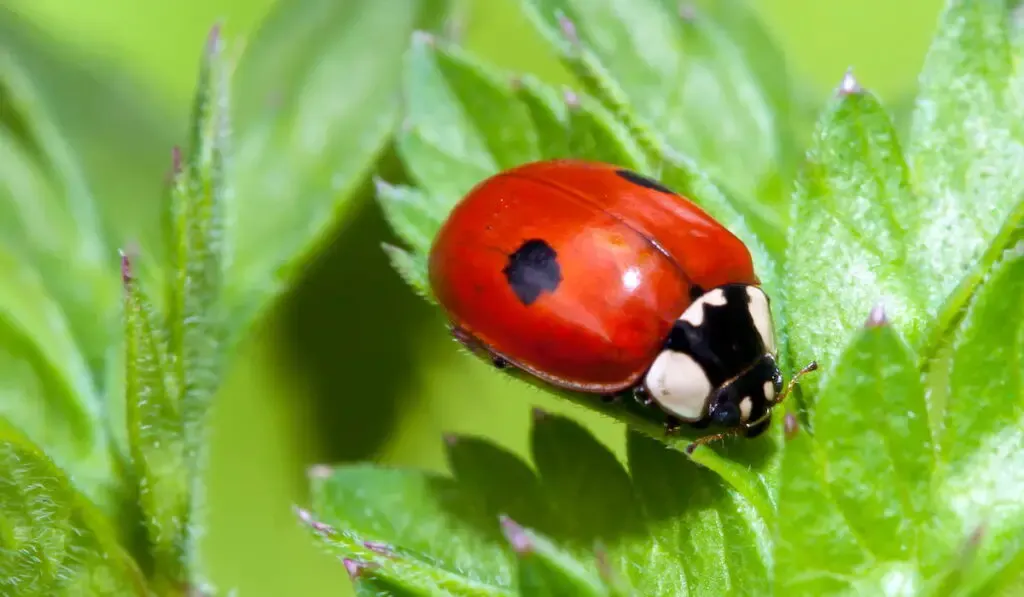Ladybugs, also known as ladybirds and lady beetles, are pretty little creatures known for their bright red colors with black spots. While the most common color of ladybugs is red, they may also come in other colors, such as grey, black, white, orange, yellow, and even pink.
If you’re wondering about the different types of ladybugs, this post will answer your question.
Table of Contents
Below are the 15 types of ladybugs and where you can find them.
1. Asian Lady Beetle (Harmonia axyridis)

Also called multicolored Asian, the Asian lady beetle is known for its various colors that range from yellow to orange to red and even black. They’re also called Halloween ladybugs or harlequins because these insects are known to occupy houses during the month of October.
However, there’s a reason why these ladybugs invade houses during Halloween time – they need to prepare themselves for the long winter period.
Asian lady beetles also have white parts on their head along with black markings that are in the shape of “M.”
Where to find them: North America, around the United Kingdom, South East and the Midlands
2. Hadda Beetle (Henosepilachna vigintioctopunctata)
Also called the 28-spotted potato ladybug, this type of ladybug is called such because they forage on agricultural crops, especially potatoes, turnips, radishes, pumpkin, beans, and spinach.
This type of ladybug is yellow-orange in color and has 14 black markings on every wing cover.
Where to find them: Hadda beetle is native to India, but they can also be found in some parts of the world, including Argentina, Australia, Brazil, and New Zealand
3. California Lady Beetle (Coccinella californica)
One physical characteristic that identifies California lady beetles from other ladybugs is that they do not have black markings on their back. Instead, they have a red domed back along with a black line that runs across the middle of their back. They have black heads and white spots on each side of the eye.
A native Californian lady beetle is about 5mm long.
Where to find them: California
4. Cardinal Ladybird (Rodolia cardinalis)
Also known as the vedalia ladybug, the cardinal ladybird is smaller and has a black body with red markings, which makes it different from other ladybugs.
Cardinal ladybugs forage on small mites, insects, and aphids. In fact, they were proven to successfully control mite infestations in orchards in Australia and California.
Adults of this type grow only 2 to 4 mm long.
Where to find them: They are native to Australia but can also be found in California
5. Convergent Ladybug (Hippodamia convergens)

The convergent ladybug is the most common native species of ladybug in North America. This type of ladybug has an oval, dark-orange body with 12 black spots that vary in size.
They feed on aphids, whiteflies, and other insects. For this reason, convergent ladybugs have proven to help curb the aphid populations.
On average, convergent ladybugs measure around 4 to 7 mm.
Where to find them: North America, mostly found in the garden or yard of households
6. Eye-Spotted Ladybug (Anatis mali)
The eye-spotted ladybug gets its name from its physical characteristics, so it’s not difficult to identify them if you see one. Each wing cover of the eye-spotted ladybug has markings that resemble small eyes, which give them a distinct look. Their color ranges from brownish-red to yellow.
Eye-spotted ladybugs are usually found in trees, or wherever aphids are present.
On average, eye-spotted ladybugs measure about 7 to 10 mm.
Where to find them: United States, Canada
7. Fifteen-Spotted Lady Beetle (Anatis labiculata)
The fifteen-spotted lady beetle is an unusual type of ladybug. Their color ranges from white to light grey to dark purple. Regardless of the color, this type of ladybug has black markings on its round, oval-shaped body. As they grow older, this type of ladybug turns dark in color to the point that their spots are almost invisible.
Like other ladybugs, the fifteen-spotted lady beetle forage on aphids. They measure about 7 to 9 mm long.
Where to find them: North America, forested areas from April to July
8. Fourteen-Spotted Ladybird Beetle (Propylea quatuordecimpunctata)

A small-sized ladybug that belongs to the family of Coccinellidae, the fourteen-spotted ladybird beetle is sometimes called “P-14.”
The P-14’s color ranges from whitish, cream, yellow, to light orange. This type of ladybug is known for its fourteen almost rectangular black spots that rarely separate. At times, the fusion of black spots results in a large marking that almost covers their yellow color.
Measuring about 3.5 to 4.5 mm, the P-14 feeds on aphids and other insects. They are mostly found on agricultural crops, gardens, fields, meadows, trees, bushes, plants, and even in woodlands.
Native to Northern Africa, Asia, and Europe, the P-14 was originally introduced to the United States – where they are continuously spreading – to control the population of Russian wheat aphids.
Where to find them: Cyprus, European Russia, Siberia, the Russia Far East, Ukraine, Belarus, Moldova, Kazakhstan, the Caucasus, Kazakhstan, Western Asia, Mongolia, Pakistan, Moldova, temperate China, Japan, Korea, and Transcaucasia
9. Orange-Spotted Ladybug (Coccinella leonine)
The orange-spotted ladybug is known for its unusual appearance. This type of ladybug has a black body with 16 yellow or orange spots. Measuring about 4.5 to 5.5 mm long, the orange-spotted ladybug is a medium-sized ladybug with an oval-shaped body.
Like other ladybug types, orange-spotted ladybugs also feed on aphids, as well as other small insects such as mites, scale insects, and mealybugs. Therefore, orange-spotted ladybugs are often found in a place where aphids and small insects are abundant.
Where to find them: New Zealand only
10. Pink-Spotted Ladybug (Coleomegilla maculata)
Also known as the twelve-spotted lady beetle, the pink-spotted ladybug has an oblong body rather than an oval-shaped one, which gives it a distinct appearance. They also have 6 black markings on each of their pink- or red-colored wings.
A large-sized ladybug, pink-spotted ladybugs measure about 6 mm long.
Aside from feeding on aphids and other small insects, the pink-spotted ladybug also feeds on plant pollen. In fact, 50% of their diet consists of pollen.
Where to find them: North America
11. Seven-spotted ladybug (Coccinella septempunctata)

Simply called “C-7,” the seven-spotted ladybug has 6 same-sized black markings on its bright-colored back. However, there is one big marking in the middle of their wings, which totals seven spots, hence their name. Their black head is similar to California lady beetles.
The C-7 is a large type of ladybug. It can grow as much as 10 mm long. They feed heavily on aphids, which makes them very useful in controlling aphid populations in grasslands and agricultural lands.
Where to find them: The seven-spotted ladybird is the most common ladybug in Europe, but they are also introduced in the United States.
12. Thirteen-spotted Ladybug (Hippodamia tredecimpunctata)
As their name suggests, the thirteen-spotted ladybug has thirteen black markings on its reddish-orange, dome-shaped body. However, their larvae are flattened instead of domed and are also covered with minute spines.
This type of ladybug feeds on aphids and is typically found on flood plains, marshes, meadows, and lakeshores. On average, thirteen-spotted ladybugs measure around 4.5 to 6.5 mm.
Where to find them: North America, they can be found from coast to coast.
13. Three-Banded Ladybug (Coccinella trifasciata)
The three-banded ladybug is named such because of the three black bands that are present on their orange bodies, which, as other people may have said, resembles a tiger.
A small-sized ladybug, three-banded ladybugs measure about only 4 to 5 mm long.
They are mostly found in brambles, gardens, meadows, fields, and yards. Like other ladybugs, they feed on aphids and other soft-bodied insects. They also eat pollen just like pink-spotted ladybugs.
Where to find them: North America, coast to coast between Mexico and Canada
14. Twenty-Spotted Ladybug (Psyllobora vigintimaculata)
The twenty-spotted ladybug is a tiny ladybug that measures about 1.75 to 3 mm only, hence their nickname “wee-tiny ladybug.” They are pale white or cream in color, with black or multi-colored spots.
This type of ladybug feeds on fungus, specifically mildews. Because of this, they are mostly found on plants that are infected with mildews, especially powdery mildews.
Where to find them: North America, except Florida and northernmost areas in Canada. However, they do exist in Alaska.
15. Two-spotted ladybug (Adalia bipunctata)

The two-spotted ladybug is a carnivorous type of ladybug that belongs to the Coccinellidae family. They are often used in greenhouses and agricultural fields as a biological control agent against aphid infestations.
An adult two-spotted ladybug typically measures around 4 to 5 mm long. Their undersides range in color from black to reddish-brown, while their orange or red wings have a single black spot on each side.
Where to find them: Europe, North America
In Conclusion
On average, ladybugs have a lifespan of 2 to 3 years in the wild, but they can live longer in a controlled habitat.
While they are known for their bright and captivating colors, only few people know the reason behind this. According to entomologists, their vivid colors serve as a warning to their predators. They also emit a certain odor to help give them an unappetizing taste, thus making them unappealing to animals that may try to feed on them.
In the end, ladybugs, lady beetles, or ladybirds, have their own contribution to our ecosystem, such as serving as pest control agents for farmers.
Sources:
- https://www.homestratosphere.com/types-of-ladybugs/
- https://leafyplace.com/types-of-ladybugs/
- https://en.wikipedia.org/wiki/Propylea_quatuordecimpunctata
- https://bugguide.net/node/view/65466
- https://val.vtecostudies.org/projects/lady-beetle-atlas/eye-spotted-lady-beetle/
- https://val.vtecostudies.org/projects/lady-beetle-atlas/fifteen-spotted-lady-beetle/
- https://val.vtecostudies.org/projects/lady-beetle-atlas/fourteen-spotted-lady-beetle/
- https://inaturalist.ca/taxa/410323-Coccinella-leonina
- https://en.wikipedia.org/wiki/Coleomegilla_maculata#Habitat
- https://en.wikipedia.org/wiki/Coleomegilla_maculata#Habitat
- https://val.vtecostudies.org/projects/lady-beetle-atlas/thirteen-spotted-lady-beetle/
- https://val.vtecostudies.org/projects/lady-beetle-atlas/three-banded-lady-beetle/
- https://wiki.bugwood.org/Coccinella_trifasciata#Distribution
- https://val.vtecostudies.org/projects/lady-beetle-atlas/twenty-spotted-lady-beetle/
- https://www.inaturalist.org/guide_taxa/367371
- https://www.inaturalist.org/guide_taxa/367371
